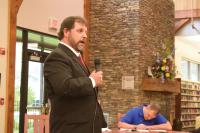Macon waiting on Peeks Creek decision
By Sarah Kucharski • Staff Writer
Streambank restoration along Peeks Creek in Macon County, where a massive landslide killed six residents following back-to-back hurricanes in September 2004, is on hold as county officials wait to hear if they will receive funds to do the project after missing initial application deadlines.
After the September 2004 flooding in Western North Carolina, the U.S. Department of Agriculture’s Natural Resources Conservation Services stepped in with a federally funded program to address emergency recovery needs. Projects eligible for the program had to address imminent threats to life and property.
“If you can wait two to three years to do it, it’s probably not an emergency,” said Mike Hinton, NRCS emergency watershed protection program manager.
In the program, 75 percent of a project’s cost is covered by federal funds and 25 percent is left to local governments. However, in the case of the floods, the state government agreed to pick up the local share.
Preliminary estimates and damage surveys showed that about $1 million was needed to restore the entirety of Peeks Creek, with approximately $590,000 of federal NRCS funds earmarked for the project. Following the floods the area looked like a war zone piled high with debris. Now the stream looks unlike any other in the region except for others similarly affected by the flood.
Related Items
The purpose of a Peeks Creek restoration project would be to stabilize streambeds so as to prevent erosion from claiming the only road that services the community.
“If we don’t move pretty soon, it’s going to cut the road away,” said Whittier-based stream restoration consultant John Boaze, who previously has worked in Macon County on Little Tennessee Greenway projects.
Additionally, restoration would help recreate a natural habitat for species wiped out by the floods.
But the problem with getting the restoration project going in Macon County first arose when the Sept. 1 deadline for all program work to be under contract passed without a plan in place.
“We ran into a little bit of a problem in that Macon County did not hire the engineering firm (McGill Associates) to begin the design work until about August,” Hinton said. “So we were really pushing that deadline to start that work.”
The stipulation to have work under contract by Sept. 1 already was a deadline extension.
“Originally, for everybody the deadline was Sept. 1 to have all the work completed, but because (NRCS officials) saw (that several counties) had a lot of environmental issues, they just couldn’t get it done,” Hinton said. “So we asked our headquarters for an extension, and they got it so that it had to be under contract by Sept. 1.”
But the extension wasn’t enough, said Macon County attorney Rich Moorefield.
“It’s been an amazing bureaucratic nightmare,” Moorefield said. “We had pretty much given up on the Peeks Creek site for not being able to satisfy these agencies.”
By waiting so long to even begin engineering Peeks Creek restoration, the county found itself looking to do streambank restoration during trout spawning season. The state Wildlife Resources Commission strongly advises against construction that would result in sedimentation being released, as dirt particles can cover and kill eggs or overcome juvenile trout. The idea behind the recommendation is to “just keep the silt at a level that these little fish can survive,” said Richard Hamilton, executive director of the North Carolina Wildlife Resources Commission.
Peeks Creek feeds the Cullasaja River, which in turn runs into the Little Tennessee, making silt an issue for each waterway.
“The concern was not necessarily Peeks Creek,” said Dave McHenry, the Mountain Region Coordinator for the Wildlife Resources Commission’s Habitat Conservation Program.
County officials believed that the Wildlife Resources’ moratorium on construction during spawning season — from October through April — prohibited them from doing any work. However, the commission only has the power to make a recommendation to the permitting agencies — the U.S. Army Corp of Engineers and state Division of Water Quality — and not the ability to hands down say “no.” It is up to the Army Corp and DAQ when permitting any project to decide how a permit is written and whether Wildlife recommendations will become mandates.
“We’re not obstructionists or anything,” Hamilton said.
Macon County officials revised their plans for stream restoration several times, allowing for compliance with Wildlife’s recommendations — which indeed were written into the original permits to do the work granted in September.
“Following the permit application, a meeting was held with all the resource agencies involved,” wrote Fish and Wildlife Inc. president Pamela Boaze, in a letter to Peeks Creek residents dated Dec. 6. “The proposed design and suggested repairs were reviewed. Because the Wildlife Resources Commission would not agree to waive the trout moratorium on work in streams from Oct. 15 to April 15, the number of repairs was reduced from 22 to nine. These nine would not involve any work in the stream.”
Also, plans were worked around local landowners’ willingness to have repairs done on their property, further reducing the number of repairs from nine to seven.
Meanwhile, NRCS essentially pulled its money off the table, holding fast to the Dec. 15 deadline to complete all emergency watershed protection work.
“A cost estimate was prepared for the repairs and a meeting with NRCS to discuss the cost estimates was held,” wrote Pamela Boaze in the letter to Peeks Creek residents. “NRCS personnel from the district and regional offices were present. They firmly held to the trout moratorium and the Dec. 15 deadline. Also, they refused to consider funding whatever portions of the project could be completed by Dec 15. They would only fund the entire project if it could be completed by Dec. 15. Peeks Creek was removed from consideration for EWP funding due to all of these obstacles.”
But consultant John Boaze didn’t think that just not doing a Peeks Creek restoration project was the answer.
“I was interested in making sure something was done on Peeks Creek,” said Boaze, owner of Fish and Wildlife Inc. “And I didn’t take no for an answer.”
On Nov. 29, Boaze called a meeting of the minds, inviting everyone from Wildlife Resources and NRCS officials to Rep. Charles Taylor, R-Brevard, and Macon County Commissioners.
“To help those most affected, a public meeting has been scheduled on Dec. 13, 2005, at 6 p.m. in the Cullasaja Fire Station, U.S. 64 east of Franklin,” Boaze wrote in a notice announcing the meeting. “This meeting will give county, state and federal officials a chance to address the residents and explain to all involved why their agency took the position that it did.”
However, Boaze’s actions caused some ire amongst involved parties and the meeting promptly was cancelled the next day.
“The issues that we’ve had maybe all have been resolved,” Moorefield said regarding the cancellation.
In a letter to the Army Corps dated Nov. 30, the Wildlife Resources Commission revised its recommendations, saying that work on Peeks Creek should be allowed on a condition basis. “The NCWRC believes that harm to trout spawning in Peeks Creek and the Cullasaja River can be effectively minimized provided the construction adheres strictly to the following: all work should be completed as soon as possible or prior to March 1, 2006; work within the stream channel is performed “in the dry” where stream flow has been diverted; disturbed stream banks should be covered with secured jute or coir matting and seeding immediately after completion of the grading or backfilling work; heavy equipment should not be operated within the stream channels,” wrote David Cox, technical guidance supervisor for the Wildlife Resources Commission’s Habitat Conservation program. “...NCWRC biologists will visit project sites to monitor construction and ensure aquatic resource protection...”
Wildlife Executive Director Hamilton said that reneging the traditional no-construction-during-spawning moratorium should not set a precedent.
“We consider every case on its individual merits,” Hamilton said.
Local NRCS officials and Macon County officials have decided the county will develop a proposal about what needs to be done and when. That proposal — developed primarily by Boaze and engineering firm McGill Associates — will be passed up the NRCS chain to make a final call as to whether an extension past the Dec. 15 deadline will be granted, Hinton said.
“That decision will be made at a Washington level,” he said.
The proposal should be in by the end of the week, John Boaze said.









